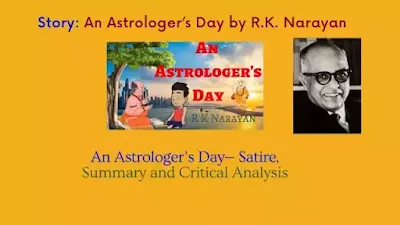
The Story as a Satire:
Fatalism and Fortune-Telling:
This story is the result of R. K. Narayan's close observation of the life of Indian people who believe in fatalism, palmistry and astrology. He has been palmists, fortune-tellers and Astrologers sitting at the road sides or under a tree surrounded by ignorant and innocent people curious to know about their future. In this story, R. K. Narayan exposes how the ignorant people are cheated by fake astrologers. He satirizes the practice or telling fortunes by examining the lines on the palm of a person.
Ignorance about Astrology:
This is a story of a person who knew nothing about astrology and palmistry. He was just a criminal. After stabbing a young man and pushing him into a well, he left his village and came to a far off town where he was unknown. In order to save himself from the eyes of police and earn his living, he passed for an astrologer. Thus, he was a criminal in disguise of an astrologer. He dressed himself as a holy man. He rubbed his forehead with sacred ash and vermilion and wore a saffron-coloured turban around his head. Thus, he posed himself as a perfect palmist although he never wanted to be an astrologer. He became a palmist just by chance. He was forced by circumstances to come to this profession.
Knowledge of Human Psychology:
The author believes that anyone with a little bit knowledge of human psychology can become a popular astrologer. The astrologer with the help of his long practice, experience and guess could tell things which not only pleased but also astonished people. He knew that people generally had problems about money, women and marriage. He listened to his customers with patience and found out answers to their queries in their own statements. He made vague and ambiguous remarks which pleased and convinced his customers. It was because of this that people were drawn to him in the same way as are bees to the colourful flowers.
Astrologer's Hypocrisy:
The astrologer was a hypocrite. He had no knowledge of palmistry or astrology but he could tell correctly about the stranger because the latter was known to him. The stranger was a person who was stabbed by him and thrown into a well. When he stood before him, he could easily identify him and tell about his past. Guru Nayak was very much impressed with him when he addressed him by his name. But the things which he told about Guru Nayak's enemy were not correct. He told him that his enemy was dead four months ago as he was crushed under a lorry, and he should not travel southward again in future as there was a great danger to his life. These things seemed convincing to Guru Nayak because he was interested in knowing whether his enemy was alive and whether he could meet him in future.
Thus, the story exposes how a criminal could pass for an astrologer and how he befooled the ignorant and innocent people by telling their fortunes with the help of his long practice, experience and guess. The author ridicules the Indian palmists and astrologers who sit at the wayside with their paraphernalia of strange and mystic things and tell fortunes of the ignorant people by making common place remarks.
Summary of the Story: An Astrologer’s Day
Personality of the Astrologer:
There was an Astrologer who earned his living by telling people things which pleased and astonished them. He had a colourful and attractive personality. He used to paint his forehead with sacred ash and vermilion. He had dark whiskers which flowed down his cheeks. He had sharp, penetrating and bright eyes which sparkled between his colourful forehead and long philosophical whiskers. To crown the effect, he used to wear a saffron-coloured around his head.
His Daily Routine:
He used to sit under the boughs of a spreading tamarind tree. He used to come to the market place at midday with a bag containing his professional articles like cowrie shells, a square piece of cloth with obscure mystic charts on it, a note book, and a bundle of Palmyra writing. He sat there all day searching for his customers. He went back home late in the evening with a few coins in his pocket.
His Ignorance about Astrology:
Though he posed as an astrologer, he had no knowledge of astrology. He had never intended to be an astrologer but the circumstances of his life made him so. He was as much a stranger to the stars as were his innocent customers. He just knew a little bit of human psychology. As a matter of study, practice and guess work, he could tell interesting things about people. Had he been in his village, he would have been a simple peasant. But by his long practice and human perception, he could easily analyze, his customer's troubles relating to money, marriage, and tangles of human ties. This was the reason why people were as naturally drawn to him as are bees to flowers.
The Arrival of a Strange Client:
One day as the astrologer was picking up his professional articles and putting them back into his bag, he saw a man standing before him. He sensed the possible client, and therefore, asked him to sit down for a while and chat with him. The stranger thrust his palm under the nose of the Astrologer and challenged him to tell about his life. The Astrologer held his palm and started saying something about his nature. The stranger asked him to tell him something worthwhile.
Challenge of the Client:
The Astrologer told him that he charged three pies per question and all that he got from him was good enough for his living. At this, the stranger flung an anna to him saying that he had some questions to ask. If he could not give satisfactory answers to his questions, he had to return that anna with interest. The Astrologer accepted his challenge saying that he would charge eight annas if he gave satisfactory answers. The stranger said to the Astrologer that he would charge twice as much if the latter was wrong. The pact was accepted after a little argument.
Astrologer's Uneasiness:
When the Astrologer saw the face of the stranger by the match light, he felt uneasy. He sent up a prayer to heaven to save him. He wanted to go back on his words. He returned the stranger's money saying that he was not used to such challenges and moreover, he was getting late for home. But the stranger was adamant. He held the Astrologer's wrist saying that he could not get out of it. The Astrologer requested him to leave him and let him go home but the latter was not prepared to do so. At last the astrologer agreed on the condition that the stranger would pay him a rupee if what he said was convincing. After a good deal of haggling the other agreed.
Astrologer's Statement about the Stranger:
The Astrologer told the stranger that the latter was left for dead. He was stabbed with a knife and pushed into a well nearby. The stranger was surprisingly pleased with what he said about him. He wanted to know from him if he could meet his opponent. The astrologer replied that he would meet him in the next world as he died four months ago. When the Astrologer addressed him by his name (Guru Nayak), be was taken aback. He advised him to go back to his village as there was great danger to his life. He gave him a pinch of sacred ash to rub on his forehead and advised him never to travel southward again. He told him that his enemy was crushed under a lorry.
Astrologer's Confession of Guilt:
After being satisfied and giving a handful of coins to the astrologer, the stranger went off. The astrologer also bundled up his articles and came back home. He counted the coins and offered them to his wife saying that he would buy nice things for his child and wife next day. After dinner, he told his wife that a great load has gone from his mind. When he was young, he nearly killed a man. That was the reason why he ran away from home, settled there and married her. He came to know that day that the man was still alive. He was relieved of a sense of guilt. He went to bed peacefully.
A Critical Appreciation of the Story:
A Satirical Story:
'An Astrologer's Day' is one of the finest satirical stories of R. K. Narayan. In this story, the author ridicules the superstitions and orthodoxy of the ignorant and illiterate people of India. He also exposes the hypocrisy of those pseudo-astrologers and palmists who sit at wayside or in the market-place and befool innocent people by telling their fortunes on the basis of the lines marked on their palms. The irony of the story is that the
Plot:
The story has a well-knit plot. The story deals with a day in the life of a person who disguised himself as an astrologer. This day is very crucial for him because it is on this day that his real self is exposed to us and he is free from the burden of guilt. The climax of the story comes when the Astrologer goes back home and tells his wife that a heavy load has gone from his heart that day.
Characterization:
Since the purpose of the story is to reveal the real character of the Astrologer, the story moves round the activities of the Astrologer. There is another character in the story. He is also very important because it is his arrival to the market-place that day that gives an opportunity to the Astrologer to expose his real colours. The author has been successful in presenting a pictorial and vivid portrait of the Astrologer.
Dialogues:
The first part of the story is descriptive. It is in the second part that the dialogues take place between the Astrologer and the stranger. These dialogues are very natural, short and simple. The story comes to an end with a homely dialogue between the Astrologer and his wife.
Title:
The title of the story is quite appropriate because the story tells us about a day in the life of the Astrologer, which was very crucial and eventful. It is on this day that he sees his enemy face to face and makes his conscience clear from that burden of guilt. It is on this day that his hypocrisy is exposed and his real character is presented before us.






